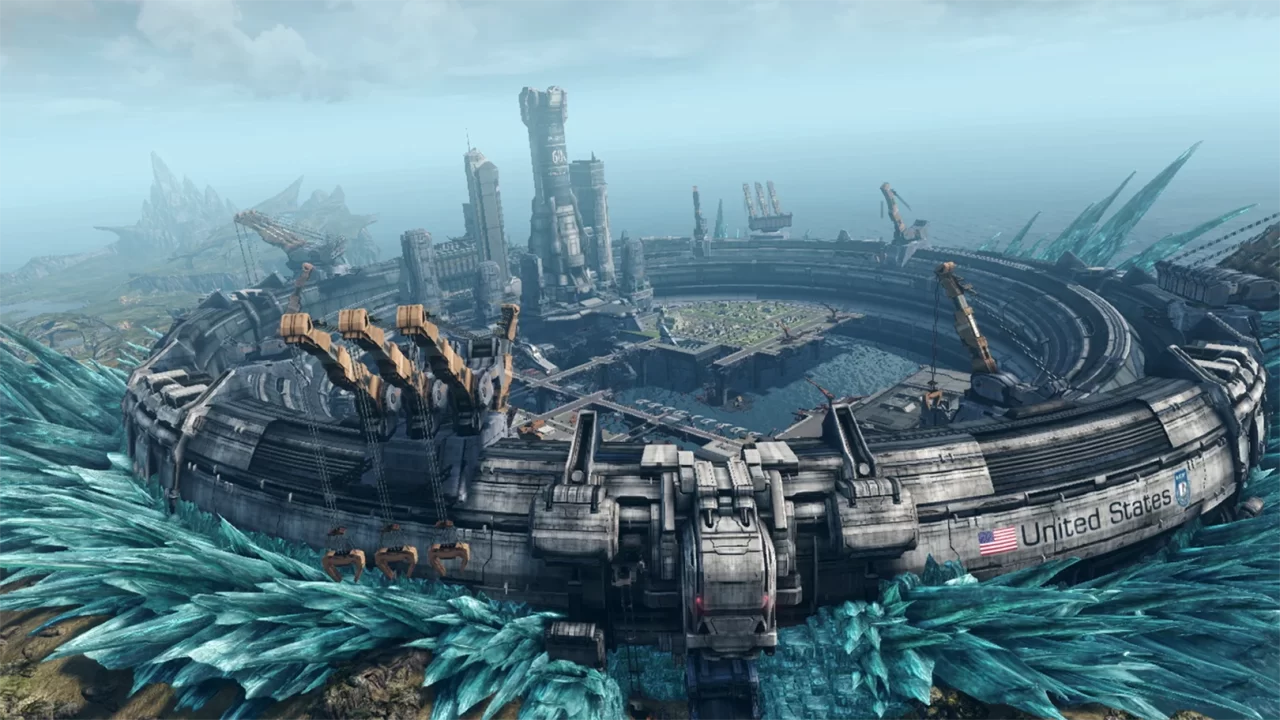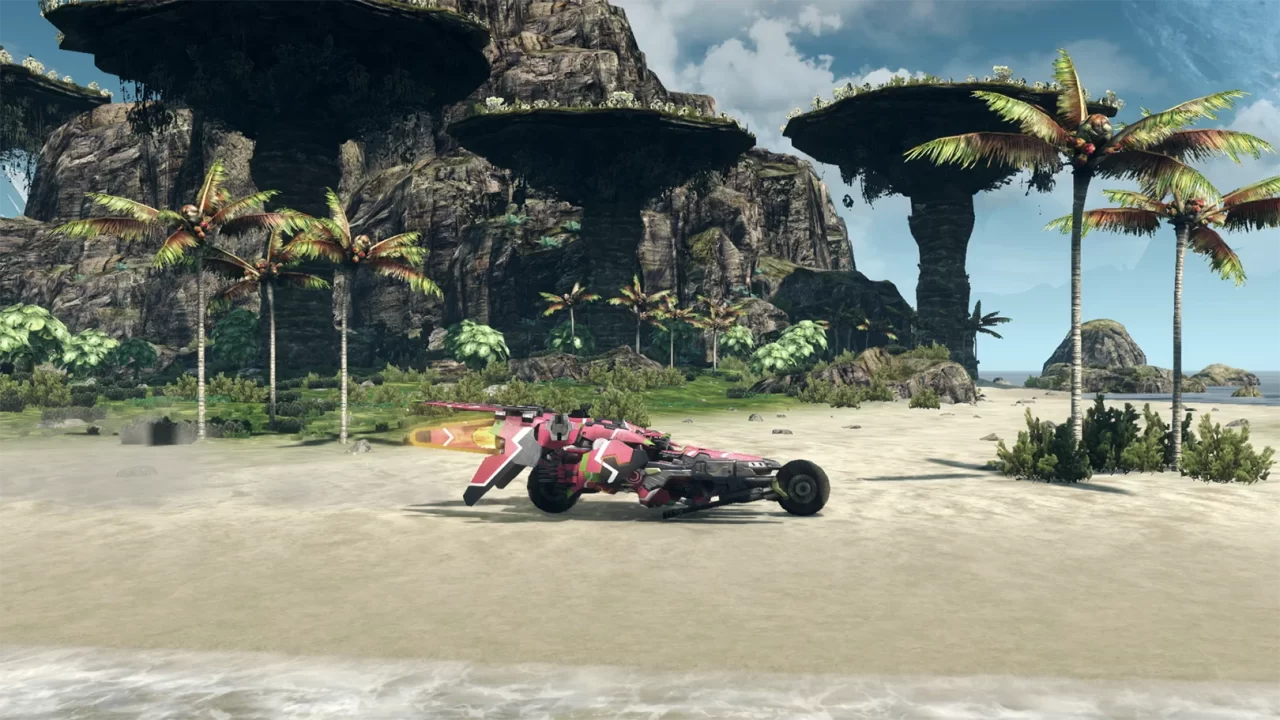It’s been a decade since the original release of Xenoblade Chronicles X, and during that time, things have changed massively for Nintendo and developer Monolith Soft. Today, Nintendo is coming off the most successful console ever made, and Monolith Soft has established itself as its premier RPG developer. In 2015, Nintendo was floundering in the home console market as the Wii U failed to meet the lofty sales heights of its predecessor. Monolith Soft was fresh off the critical success and long, arduous journey to global release for their first flagship RPG produced under Nintendo ownership, Xenoblade Chronicles. Not content to rest on their laurels, studio head Tetsuya Takahashi and his team of RPG veterans set out to completely reinvent the series they had just established.
Xenoblade Chronicles X eschewed the linear, character-driven storytelling and science fantasy setting of Xenoblade Chronicles for a hard sci-fi open world setting that focuses heavily on gameplay mechanics and world exploration. X brought the most expansive, contiguous open world the team had ever created and introduced online multiplayer to the series, ramping up the sense of scale the original was so beloved for. The result was a diamond in the rough —a thoroughly unique experience compared to other open-world RPGs and unlike anything else on Nintendo platforms at the time, yet one that failed to course-correct the failed console and thus remained marooned on the Wii U.
This commercial failure left many Xenoblade series fans unable to experience the title that laid the technical groundwork for Monolith Soft’s later success. That injustice has finally been rectified, as Monolith Soft has returned to the black sheep title for the enjoyment of new fans gained over the decade. Xenoblade Chronicles X: Definitive Edition retains the original’s core identity and unique structure while polishing the rougher patches and seamlessly integrating new narrative content and gameplay elements that elevate the already fantastic original into a masterpiece.
Xenoblade Chronicles X: Definitive Edition begins in an era of turmoil and disaster. Earth is under attack from an unknown hostile alien force that seeks to destroy the planet. Humanity, forewarned of their impending doom, banded together to build a group of interplanetary arks to escape their fate. One of these arks, the White Whale, manages to break free of the alien blockade and escape into space. However, the alien pursuers track the ship down, forcing the ark to crash land on the hostile alien planet Mira. The human refugees quickly establish the city of New Los Angeles and venture into the untamed wilderness of Mira, hoping to make the land suitable for human life and establish defenses against the alien force hunting them.
In a major break from the other games in the series, you are a player-created avatar in Xenoblade Chronicles X: Definitive Edition. This is a necessary concession for the game’s online multiplayer features, and also serves an important narrative purpose as the main character and player are equally ignorant about the planet and humanity’s situation. Your character is awakened from a lifepod by Elma, a member of the BLADE organization tasked with protecting humanity and establishing a foothold on Mira. Elma is an experienced soldier and takes you under her wing, mentoring you as you rise in the ranks of BLADE and search for the Lifehold, the core unit for the White Whale that sustains all human life on the planet. This search eventually forces your avatar and the other members of BLADE to contend with dangerous indigenous lifeforms (indigens), other sentient Xenoform species marooned on the planet, and the hostile alien force that destroyed Earth, called the Ganglion.
Xenoblade Chronicles X‘s narrative is fundamentally a story of war, conquest, colonization, political upheaval, and social cooperation across vastly different societies. Each sentient alien species has its unique culture and customs, and humanity must learn to coexist to survive on Mira. From the cute and cuddly series mascot Nopon, to the technologically advanced and intellectual Manon, to the tribal and warlike Prone, each species has a complex background and relationship to the planet or the Ganglion, and much of the story and the game’s side content see your party navigating these societal differences and dealing with the inevitable conflict that arises in the face of the Ganglion threat.
While the main story focuses on the core narrative of survival and the fight against the Ganglion, the majority of the game’s world-building and thematic depth lies within the side missions. Chief among these are Affinity Missions that focus on a single character, usually a party member, and flesh out their backstory and motivations. Each character has multiple Affinity Missions spread across the game, with progress gated by your bonds with them. These bonds are developed through character interactions in the copious number of Normal Missions, with certain dialogue choices resulting in increased favor among the party members you bring along with you. This system ensures that your bonds with each character progress organically as you spend time with them, giving you an additional layer of agency and role-playing opportunity.
The aforementioned Normal Missions form the bulk of Xenoblade Chronicles X: Definitive Edition’s content; despite their basic foundation built on simple tasks such as gathering resources or defeating indigens, the framing of these tasks elevates them to something much more meaningful than simple fetch quests. Contained in these missions are stories of prejudice between traumatized humans reeling from the destruction of their home and these unfamiliar alien species, often with disastrous and heartbreaking consequences.
Others are tales of interspecies cooperation, camaraderie, and even love. During my 70+ hours with Xenoblade Chronicles X: Definitive Edition, I officiated an alien wedding, bore witness to a horrifying alien parasite taking over the bodies of unwitting humans ala The Thing, and thwarted disgruntled human attempts to decimate a friendly alien species through manipulative religious doctrine. Many of these storylines contain unique cutscenes and locations, and the sheer volume of high-quality storytelling is awe-inspiring, in what would be disposable checklist-ticking in a lesser open-world title. Takashi and his team estimated that they invested 3,000% more effort into the quest design and sidequest writing compared to the original Xenoblade Chronicles, and the result is one of the few RPGs where the side quests truly feel as impactful and lovingly crafted as the main scenario.
This commitment to meaningful side content meshes perfectly with Xenoblade Chronicles X’s mechanical pillars of combat and exploration. Although I’ve spent much of this review talking about the game’s narrative, the main focus of the game design is on combat and exploration mechanics in equal parts. Combat is real-time and governed by cool-down-based abilities and positioning, much like the original Xenoblade Chronicles. However, Xenoblade Chronicles X evolves this system by including a robust class system. You choose between three base classes, each with two tracks of advanced tiers. Each class has a specific weapon pair (these govern active combat abilities) and unique passive skills. You can mix and match these active abilities and passive skills between classes once mastered, and each party member has their unique variation of each class. The character-building and party composition choices are staggering, and many of the game’s most powerful enemies (known as Tyrants) require specific setups and builds to take down.
Further enhancing this party-building aspect is the Soul Voice System. Soul Voices are quick-time events triggered in battle by performing the right type of ability requested by an ally, and deliver beneficial effects such as buffs and healing. This opens up party composition as a dedicated healing character is no longer necessary, forcing you to pay close attention to your ability setups and those of your party members to ensure that everyone has the right loadout tuned to their accompanying Soul Voices. This also keeps battles active and engaging, since you must juggle activating abilities and staying in position in real time with fast-moving Soul Voice events to get the most out of combat.
This variety of choice and depth in character progression form a cohesive whole with the exploration gameplay, as nearly everything you do on Mira helps develop your characters. Discovering new points of interest rewards experience, unearthing supply caches and treasure spots generates battle points to unlock new skills; planting probes for the FrontierNav map continuously generates resources for developing new equipment. The moment-to-moment experience of exploring the world is excellent, not just because of the rewards, but because the core gameplay mechanics are sublime. Movement is fast and fluid on foot with a blistering running speed, massive jumping height, and the absence of fall damage that encourages you to scale every surface possible. The sense of control over your character on foot and in massive Skells is tight and responsive, aided by the improved stability offered in the Definitive Edition. Frequent performance drops plagued the game on Wii U, but on new hardware, the game runs at a consistent 30 FPS with very few drops even in the most demanding encounters.
You spend your initial hours of Xenoblade Chronicles X in this on-foot phase, where the vast scale of the world is incredibly imposing. Everything changes when you unlock Skells, the towering mecha that are the backbone of humanity’s defense. Skells can transform into vehicles that quickly race across Mira’s varied terrain and jump to lofty heights to access areas impassable on foot. Skells also bring a new variation to combat, allowing you to fight foes too strong to fight on foot. The third phase arrives when you unlock the flight module for Skells, opening up new sections of the map that are accessible only by air and eliminating much of the risk and travel time inherent to traveling along Mira’s inhospitable ground. The world design is superb with many secrets to find, logical enemy placements that fit the behavior of the various lifeforms on Mira, and topographical variety unmatched by any game before or since. Mira truly feels like a living, breathing world and is the high point of Monolith Soft’s immersive world design.
Xenoblade Chronicles X: Definitive Edition brings numerous improvements to this core mechanical framework. While the small changes are too numerous to list here (Good Vibes Gaming has an excellent breakdown of all the changes), there are some significant additions and reworks of gameplay mechanics that I want to highlight. First is the biggest change to the combat system: the Quick Cooldown bar. Previously, combat encounters could be fairly lengthy as you waited for cooldown timers to finish to activate skills. This time, Monolith Soft added a Quick Cooldown bar that allows you to expend a portion of the bar to instantly refresh an ability on cooldown. This massively changes the pace of fights, particularly against weaker enemies. Now, instead of waiting for abilities to refresh during a fight that you will inevitably win, you can effectively spam your abilities to make quick work of weaker foes.
You can also be more responsive to party member Soul Voice callouts, as you almost always have access to fire off whatever particular type of skill they are asking for, instead of missing the window due to a long cooldown. However, this addition remains balanced, as the bar cannot be refilled during combat encounters, and using the Quick Cooldown to refresh an ability only grants you the first stage of that ability instead of significantly more powerful, fully-charged stage two abilities. In longer fights against tough foes or groups, careful management of the Quick Cooldown bar is necessary so you don’t run out of uses.
The biggest change to world exploration is the removal of BLADE levels. This was the primary gatekeeping system in the Wii U version. Even if you made it to a hard-to-reach resource spot or progressed far enough to access a new questline, oftentimes your BLADE level would be too low to interact with the node or accept the quest. Without that system of arbitrary and artificial barriers, exploration feels more rewarding and organic. Another fantastic addition is that planting probes for FrontierNav gives you significant rewards, providing additional incentive to fill out as much of the map as possible. These changes deliver a smoother gameplay experience and remain cohesive with the core tenets of Xenoblade Chronicles X’s game design ethos.
The most impactful addition to Xenoblade Chronicles X: Definitive Edition is the inclusion of new party members and an epilogue set after the conclusion of the main story. The new party members each bring something valuable to the table and are expertly woven into the context of the original story, such that I doubt any first-time player would even notice that they weren’t in the original game. Neilnail is a Qlurian cosmoarchaeologist who is on Mira to study its history, and her Affinity Missions provide much-needed insight into the origins & culture of her people and that of Mira. Leisel is an ace Skell pilot whose storyline revolves around corporate greed & subterfuge, and introduces a completely new model of Skell more powerful than many of the base game Skells.
Perhaps the most controversial aspect of the original release was the eclectic soundtrack. Composed by Hiroyuki Sawano, the score features tracks that encompass a wide variety of styles and genres, unlike the bombastic orchestral scores of the other Xenoblade titles. There are still epic, sweeping scores (my personal favorite being “Noctilum“), but the score does an excellent job of creating an alien, otherworldly atmosphere through tracks like “Manon” and “Wir fliegen.” Fan reception to many of the vocal-heavy tracks has always been mixed, but I love them (same for the crew of Rhythm Encounter Episode 156) and believe they fit the vibe of Xenoblade Chronicles X perfectly. For those who don’t like the vocal tracks, Xenoblade Chronicles X: Definitive Edition adds an instrumental version of Skell Flight Module theme “Don’t Worry,” which can be switched on at any time through the menu. There are a whole host of new tracks included for the epilogue that I won’t spoil here, but effortlessly fit into the audio tapestry of Mira’s beautiful alien world.
Xenoblade Chronicles X on Wii U was infamous for its unresolved narrative cliffhanger, and Xenoblade Chronicles X: Definitive Edition seeks to rectify this injustice through a lengthy, multipart epilogue. The result is mostly a success, as it answers many questions surrounding Elma’s origins and the nature of humanity’s technological development, and explores the motivations of the Ganglion. Unfortunately, many epilogue sequences are defined by overlong exposition dumps, as Monolith Soft attempted to fit an entire sequel’s worth of narrative outline into a 10–15 hour epilogue. The narrative shifts to a more metaphysical direction, connecting X directly with the other Xenoblade games (and even Xenosaga and Xenogears to a certain extent), and offers some interesting philosophical considerations on the nature of the human spirit. The original narrative touched on these ideas, but the epilogue explores them more deeply, simultaneously dropping some of the narrative threads present in the original game. It also leaves the door open for a potential follow-up, and I hope Monolith Soft takes the opportunity to expand on the excellent mechanical and thematic foundation they’ve built for a true sequel.
Xenoblade Chronicles X: Definitive Edition is the best iteration of Monolith Soft’s impressive open-world masterpiece. I’m so happy that the game is on a platform many people own, so they can finally experience the wondrous world of Mira for the first time, just as I did in 2015. Xenoblade Chronicles X is the most impressive execution of the open-world concept I’ve ever experienced, and the fact that it retains that lofty designation for me even after ten years and countless open-world RPGs is a testament to Monolith Soft’s monumental achievement in RPG game design.






